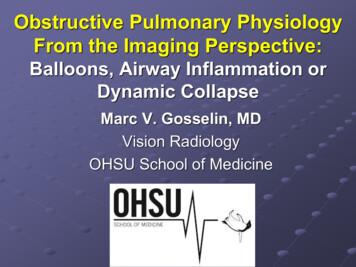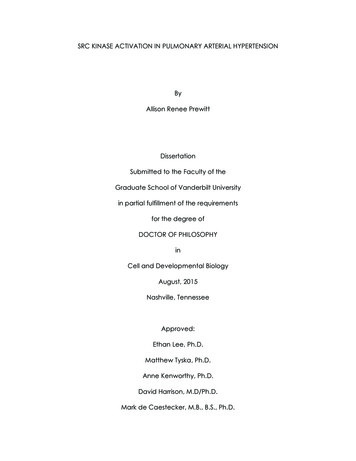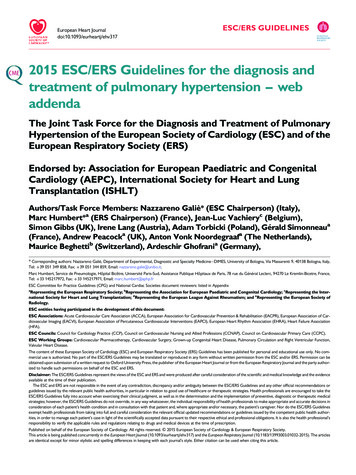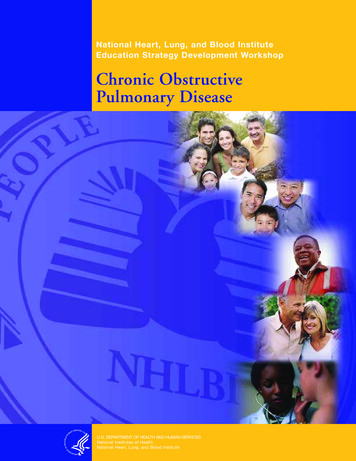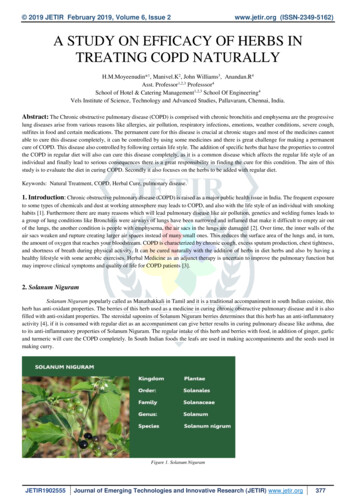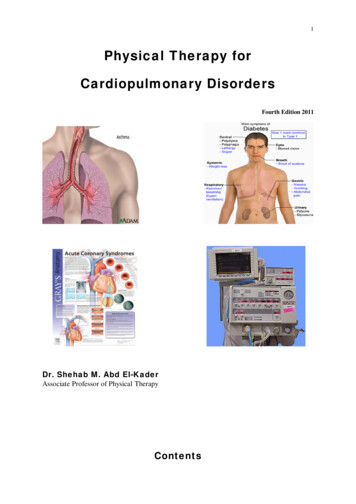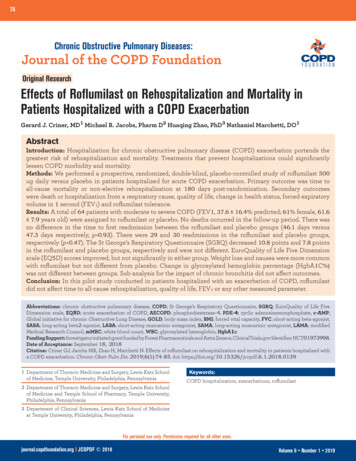
Transcription
74Roflumilast Effect on COPD RehospitalizationChronic Obstructive Pulmonary Diseases:Journal of the COPD FoundationOriginal ResearchEffects of Roflumilast on Rehospitalization and Mortality inPatients Hospitalized with a COPD ExacerbationGerard J. Criner, MD1 Michael R. Jacobs, Pharm D2 Huaqing Zhao, PhD3 Nathaniel Marchetti, DO1AbstractIntroduction: Hospitalization for chronic obstructive pulmonary disease (COPD) exacerbation portends thegreatest risk of rehospitalization and mortality. Treatments that prevent hospitalizations could significantlylessen COPD morbidity and mortality.Methods: We performed a prospective, randomized, double-blind, placebo-controlled study of roflumilast 500ug daily versus placebo in patients hospitalized for acute COPD exacerbation. Primary outcome was time toall-cause mortality or non-elective rehospitalization at 180 days post-randomization. Secondary outcomeswere death or hospitalization from a respiratory cause, quality of life, change in health status, forced expiratoryvolume in 1 second (FEV1) and roflumilast tolerance.Results: A total of 64 patients with moderate to severe COPD (FEV1, 37.6 16.4% predicted; 61% female, 61.6 7.9 years old) were assigned to roflumilast or placebo. No deaths occurred in the follow-up period. There wasno difference in the time to first readmission between the roflumilast and placebo groups (46.1 days versus47.3 days respectively, p 0.93). There were 29 and 30 readmissions in the roflumilast and placebo groups,respectively (p 0.47). The St George’s Respiratory Questionnaire (SGRQ) decreased 10.8 points and 7.8 pointsin the roflumilast and placebo groups, respectively and were not different. EuroQuality of Life Five Dimensionscale (EQ5D) scores improved, but not significantly in either group. Weight loss and nausea were more commonwith roflumilast but not different from placebo. Change in glycosylated hemoglobin percentage (HgbA1C%)was not different between groups. Sub-analysis for the impact of chronic bronchitis did not affect outcomes.Conclusion: In this pilot study conducted in patients hospitalized with an exacerbation of COPD, roflumilastdid not affect time to all-cause rehospitalization, quality of life, FEV1 or any other measured parameter.Abbreviations: chronic obstructive pulmonary disease, COPD; St George’s Respiratory Questionnaire, SGRQ; EuroQuality of Life FiveDimension scale, EQ5D; acute exacerbation of COPD, AECOPD; phosphodiesterase-4, PDE-4; cyclic adenosinemonphosphate, c-AMP;Global initiative for chronic Obstructive Lung Disease, GOLD; body mass index, BMI; forced vital capacity, FVC; short-acting beta-agonist,SABA; long-acting beta2-agonist, LABA; short-acting muscarinic antagonist, SAMA; long-acting muscarinic antagonist, LAMA; modifiedMedical Research Council, mMRC; white blood count, WBC; glycosylated hemoglobin, HgbA1cFunding Support: Investigator initiated grant funded by Forest Pharmaceuticals and Astra Zeneca. ClinicalTrials.gov Identifier: NCT01973998.Date of Acceptance: September 18, 2018Citation: Criner GJ, Jacobs MR, Zhao H, Marchetti N. Effects of roflumilast on rehospitalization and mortality in patients hospitalized witha COPD exacerbation. Chronic Obstr Pulm Dis. 2019;6(1):74-85. doi: https://doi.org/10.15326/jcopdf.6.1.2018.01391 Department of Thoracic Medicine and Surgery, Lewis Katz Schoolof Medicine, Temple University, Philadelphia, Pennsylvania2 Department of Thoracic Medicine and Surgery, Lewis Katz SchoolKeywords:COPD hospitalization, exacerbations, roflumilastof Medicine and Temple School of Pharmacy, Temple University,Philadelphia, Pennsylvania3 Department of Clinical Sciences, Lewis Katz School of Medicineat Temple University, Philadelphia, PennsylvaniaFor personal use only. Permission required for all other uses.journal.copdfoundation.org JCOPDF 2019Volume 6 Number 1 2019
75Roflumilast Effect on COPD RehospitalizationAddress correspondence to:Gerard J. Criner, MDDepartment of Thoracic Medicine and SurgeryLewis Katz School of Medicine at Temple University745 Parkinson Pavilion3401 North Broad StreetPhiladelphia Pa 19140Phone: 215 707-8113Email: gerard.criner@tuhs.temple.eduIntroductionChronic obstructive pulmonary disease (COPD) afflicts24 million U.S. residents and is the 4th leading cause ofdeath .1,2 COPD exacerbations add considerably to thatburden because they cause frequent hospitalizationsand readmissions, contribute directly to the deathof many patients, dramatically reduce quality of life,consume the majority of resources used to manageCOPD, and may hasten the progressive loss of lungfunction.3,4 Acute exacerbations of COPD (AECOPD)account for 31% to 68% of the total costs of COPDcare in the United States.5,6 Treatment that preventsor ameliorates frequent or severe AECOPD couldsignificantly lessen COPD morbidity and mortality aswell as rtant in COPD patients because they profoundlyimpact patient survival, function, symptoms and healthstatus as well as account for a significant componentof COPD-related costs. A review of patients fromthe Evaluation of COPD Longitudinally to IdentifyPredictive Surrogate Endpoints (ECLIPSE) study7showed that a prior history of being hospitalized foran acute exacerbation was associated with the greatestrisk of readmission (47%), and that 15% of patientsreported multiple readmissions. Importantly, thosewith repeat hospitalizations had significantly increasedmortality at 1 year.The heightened inflammation that occurs duringan acute exacerbation, especially a hospitalizedexacerbation, may contribute to the higher rates ofmorbidity and mortality. COPD exacerbations arelinked to increased airway inflammation driven byneutrophils within the airway lumen, and elevatedlevels of pro-inflammatory cytokines and mediatorsof oxidative stress (e.g., higher lipid peroxidationbyproducts); up-regulated CD11/CD18 neutrophiladhesion molecules; and increased cytochromeoxidase activity that are also found in the systemiccirculation.8-11 Increases in systemic inflammationmay contribute to the increased incidence of majorcardiac events associated with acute exacerbations ofCOPD.12Roflumilast is a potent inhibitor of thephosphodiesterase-4 (PDE-4) pathway and is reportedto have protean anti-inflammatory propertiessuch as inhibiting hydrolysis of cyclic adenosinemonophosphate (c-AMP) in inflammatory cells anddecreasing neutrophilic release of inflammatorymediators and cytokines while decreasing apoptosisand expression of cell surface markers.13,14 Studiesin patients with moderate to severe COPD whowere given roflumilast have reported significantimprovements in forced expiratory volume in 1 second(FEV1) measurements and a moderate reductionin exacerbation rates.15,16 Post hoc analyses ofthe REACT and RE2SPOND studies suggest thatroflumilast is most effective in reducing the ratesof moderate or severe exacerbations in a subgroupof patients who have been hospitalized with anexacerbation of COPD within the past year.17-19These findings highlight the potential importancethat roflumilast may have on decreasing the intensityof respiratory symptoms around the time of an acutesevere exacerbation that requires hospitalization, andits potential benefit on reducing mortality and the needfor readmission. However, despite data suggesting thatpatients hospitalized with a COPD exacerbation maybenefit the most from roflumilast to decrease futureevents, there is no data that demonstrates the safetyand efficacy of administering roflumilast to patientswith moderate to very severe COPD while clinicallyunstable during the index hospitalization, or shortlythereafter.In this pilot study, we assessed the safety and efficacyof roflumilast initiated in patients with moderate tovery severe COPD while hospitalized with an acuteexacerbation, with and without a history of chronicbronchitis, on time to all cause rehospitalization ordeath during the 180 days post initiation of treatment.MethodsStudy DesignWe conducted a parallel-group, prospective,randomized, double blind, placebo-controlled trial ofroflumilast 500 ug daily versus placebo in patientsfollowing hospitalization for a COPD exacerbation atFor personal use only. Permission required for all other uses.journal.copdfoundation.org JCOPDF 2019Volume 6 Number 1 2019
76Roflumilast Effect on COPD Rehospitalizationa single center. This was done to detect a treatmenteffect as the initial step to complete a power analysisin preparation to conduct a larger, multicenter,prospective, randomized and controlled trial. (Figure1). The study was approved by our Institutional ReviewBoard for Human Research at Temple University (IRB#21474).OutcomesOutcomes included: (1) Primary: Time to all-causemortality or rehospitalization during the 180 days postrandomization to treatment; (2) Secondary: Respiratorydeath or respiratory rehospitalization at 180 days postrandomization; rate of death or readmission during the30 days post-discharge; change in FEV1, and dyspneafrom baseline to 180 days post-randomization; (3)Other: tolerance of roflumilast versus placebo inpatients hospitalized due to AECOPD.Study PopulationThe study population consisted of 68 patientshospitalized with AECOPD at Temple UniversityHospital.Inclusion CriteriaInclusion criteria consisted of a primary diagnosisof AECOPD defined as acute increase in dyspnea,sputum volume, and/or sputum purulence withoutother identified cause; hospitalization; patient agegreater than 40 and less than 80 years old; cigarettesmoking 10 pack years; informed written consent.Exclusion CriteriaExclusion criteria included a prior diagnosis or highsuspicion for asthma based on investigator judgment;pulmonary edema, pneumonia, interstitial lung diseaseor significant bronchiectasis based on admission chestx-ray; intubated and mechanically ventilated at thetime of evaluation; active liver disease, or transaminaseelevations ( 3xULN); history of alcoholism or heavyethanol use; history of suicidal behavior 2 yearsor suicidal ideation 6 months prior to enrollment;pregnant or lactating females. Those taking excludedmedications: P450 inducers (e.g., rifampicin,phenobarbital, carbamazepine, and phenytoin) andCYP3A4 inhibitors or dual inhibitors that inhibitboth CYP3A4 and CYP1A2 simultaneously (e.g.,erythromycin, ketoconazole, fluvoxamine, enoxacin,cimetidine) were also excluded from the study.Study Design and SynopsisBaselinePatients were enrolled after admission to the hospital.Both groups received Global initiative for ObstructiveLung Disease (GOLD) guideline-recommendedcare.20 At baseline, all patients had a medical historyand physical examination with spirometry performed.Women with the potential to become pregnantwere given a pregnancy test. Dyspnea scales, DeyoCharlson index, and GOLD classification wereperformed. Patients completed a Columbia SuicideSeverity Rating Scale to exclude patients with a historyof suicidal behavior 2 years or suicidal ideation 6months prior to enrollment.RandomizationPatients were randomized to 1 of 2 treatment groupsusing a randomized block design. One group receivedroflumilast 500 mcg (Daliresp ) daily and the otherreceived a matched placebo tablet. Patients wereallocated to one of these treatment arms prior tohospital discharge for a total period of 180 days postenrollment.Day of Hospital DischargeOn the day of discharge, spirometry was performedand a questionnaire assessing any adverse eventsduring the hospitalization was completed.MeasurementsDemographics and Medical HistoryAge, gender, body mass index (BMI), presence ofcomorbidities, current medical therapy, history ofpulmonary rehabilitation, influenza and pneumococcalvaccinations, emergency department visits andhospitalizations during the last year, number ofexacerbations in prior year, history of coronaryartery disease, stroke, transient ischemic attacks, andperipheral vascular disease were documented. TheDeyo-Charlson index21 was used to assess the impactof other chronic illnesses on outcome.SpirometrySpirometry was performed (post bronchodilatoradministration) at the time of enrollment (baseline)or as soon as the participant was able to performspirometry while hospitalized, at the day of dischargeand then 180 days post randomization.22 Airflowobstruction was defined by postbronchodilatorFor personal use only. Permission required for all other uses.journal.copdfoundation.org JCOPDF 2019Volume 6 Number 1 2019
77Roflumilast Effect on COPD Rehospitalizationmeasured FEV1 to forced vital capacity (FVC) ratio 70% and FEV1 70% predicted at time of inclusionand was used to define GOLD Stages.Quality of Life and Functional StatusPatients completed general and disease-specific,self-administered quality of life and functionalquestionnaires:EuroQol Five Dimension scale23and the St George’s Respiratory(EQ5D)Questionnaire (SGRQ).24 The Columbia–SuicideSeverity Rating Scale (C-SSRS)25 was used toprospectively assess suicidal ideation and behaviorusing a structured interview face to face for patientresponses.Measurements of DyspneaDyspnea was measured by the modified MedicalResearch Council (mMRC) Dyspnea score.Description of Optimized Standard Care forCOPD ExacerbationsAll patients received standardized, optimized care forAECOPD. Noninvasive positive pressure ventilationwas utilized at the discretion of the treating physiciansbut followed accepted guidelines.26Drug/Placebo SupplyRoflumilast and matching placebo were provided byForest Laboratories and subsequently Astra Zenecaand stored by the Investigational Pharmacy Unit atTemple University Hospital.Statistical MethodsThis was a pilot study and the intent was to determineif there is a signal that would justify a larger clinicaltrial. Therefore, the significance level was set to 0.1For personal use only. Permission required for all other uses.journal.copdfoundation.org JCOPDF 2019Volume 6 Number 1 2019
78Roflumilast Effect on COPD Rehospitalizationand the power was set at 0.7. A total of 100 patientsis required in a 2 treatment parallel-design study.There is a 70% probability that the study will detecta treatment difference at a 2-sided 10% significancelevel, if the true hazard ratio is 1.654. This is basedon the assumption that the accrual period will be 36months and the follow up period will be 6 monthsand the median time to event is 8 months. The totalnumber of events will be 73.Vital status was determined for all randomizedpatients for the intention to treat analysis. Dataare presented as the mean (standard deviation) forcontinuous variables. Statistical comparisons wereperformed using the Student’s t-test for continuousdata and χ2 test for categorical data. Categorical andcontinuous data were analyzed using JMP Pro 13.0.0 2016 SAS Institute. Event-free survival curves weredetermined by Kaplan-Meier analysis, and differencesbetween survival curves were compared using the logrank test. Event was defined as the first readmissionor death. Univariate and multivariable Cox regressionwas done using Stata release 15. P values less than0.05 are considered statistically significant.ResultsPatient PopulationOver 500 patients were prescreened to determineeligibility for the trial. Most were initially excludedbecause they were identified outside of a 12-hour timeenrollment window post hospitalization; because ofthis, the enrollment window was increased to begin theinvestigational drug while hospitalized. Ultimately,88 patients were screened for study enrollment and 64were enrolled. The consort diagram for the study isprovided in Figure 1.Patient DemographicsBaseline characteristics are provided in Table 1 . Theroflumilast and placebo groups were well matched onmost clinical characteristics including sex, smokinghistory, number of COPD exacerbations in the yearprior to enrollment, level of airflow obstruction,fibrinogen levels and total white blood count (WBC),SGRQ and EQ5D scores, distribution of mMRCscores and baseline respiratory medication use. Thegroup assigned to roflumilast were slightly older thanthe placebo group and had eosinophil levels thatwere statistically significantly higher at the time ofFor personal use only. Permission required for all other uses.journal.copdfoundation.org JCOPDF 2019Volume 6 Number 1 2019
79Roflumilast Effect on COPD Rehospitalizationenrollment.Chronic Bronchitic PhenotypeChronic bronchitis was identified using the first 2responses on SGRQ. Individuals were classified ashaving SGRQ chronic bronchitic phenotype if theyanswered “almost every day” or “most days a week” tothe following questions: “Over the last 4 weeks, I havecoughed:” and “Over the last 4 weeks, I have broughtup phlegm (sputum).27 Twenty-seven patients werefound to have a chronic bronchitic phenotype basedon this methodology. The distribution between the2 groups was uneven (33% roflumilast versus 67%placebo) although this did not quite reach statisticalsignificance.Primary Outcome Parameter:Time to COPDReadmission or DeathThe primary outcome for the study was the differencebetween placebo and roflumilast on the time to first allcause rehospitalization or death. Although 2 patientsdied (both assigned to the active treatment groupduring the initial hospitalization) there were no deathsthat occurred in the follow-up period. There was nodifference in the time to first readmission between theroflumilast and placebo groups (54 days versus 55days respectively [p 0.93]). (Figure 2)Secondary Outcome ParametersThere was a total of 31 and 35 all-cause readmissionsin the roflumilast and placebo groups respectively(p 0.93). (Table 2)Change in Quality of Life ScoresSGRQ scores for both the roflumilast and placebogroups improved from the point of hospital dischargeto the 180-day study visit. SGRQ decreased an averageof 10.8 points and 7.8 points in the roflumilast andplacebo groups, respectively. No significant differenceswere detected between groups. (Table 2)The EQ5D scores improved slightly, but notsignificantly in both the roflumilast and placebogroups. No difference between groups was detected.Change in Glycosylated Hemoglobin PercentageThe gylcosylated hemoglobin percentage (HgbA1c%)dropped slightly in both groups. No significantdifference between groups. (Table 2)Univariate and Multivariable AnalysesTwo characteristics were found to be significantlydifferent between the roflumilast and placebo groups atbaseline, age and eosinophil levels whether reported asa percentage or as an absolute number. To determinethe effect of underlying clinical characteristics on thetime to first exacerbation, a standard least squaresregression model was developed that included thepatient’s age and percentage of eosinophils as theseFor personal use only. Permission required for all other uses.journal.copdfoundation.org JCOPDF 2019Volume 6 Number 1 2019
80Roflumilast Effect on COPD Rehospitalizationwere statistically significantly different betweengroups at baseline. Also included in the model werethe number of prior exacerbations, which is knownto affect the rate of future exacerbations and thenumber of pack years of smoking. The results of theunivariate analysis are found in Table 3. As shown,the time to admission was related to the number ofprior acute exacerbations and a higher percentage ofeosinophils in the peripheral blood. Pack years, age,and treatment group assignment did not influencetime to readmission. Percentage of eosinophils andnumber of prior exacerbations remained significant inthe multivariable analysis (Table 4).DiscussionIn this single center, prospective, randomizedand placebo-controlled pilot study conductedin patients hospitalized with an exacerbation ofCOPD, roflumilast had no effect time on all-causemortality or rehospitalization during the 180 dayspost-randomization to treatment, on the number ofrespiratory deaths or respiratory rehospitalizationsduring the 180 days post-randomization; on ratesof death or readmission during the 30 days postdischarge; and changes in dyspnea during the 180 dayspost-randomization. We found no effect of roflumilaston any of these parameters in the subgroup of patientswith the chronic bronchitic phenotype. Tolerance ofroflumilast in patients during the period surroundingthe hospitalized COPD exacerbation was limited dueto nausea and loose stools, fatigue, weight loss andheadache with a frequency and severity that was similarto prior reports (Table 5). Two large, multicenteredtrials have shown that roflumilast, as an add-on therapyto inhaled bronchodilators in patients with moderateto severe COPD and a history of chronic bronchitisand prior exacerbations, had a 48 ml increase in FEV1and 17% reduction in the rate of moderate and severeexacerbations of COPD compared to placebo at 52weeks.28Another post hoc analysis of the same datasetpooling patients from the 2 studies and classifyingthem as frequent ( 2 events in prior year) orinfrequent exacerbators ( 2 events) showed thattreatment with roflumilast shifted patients from thefrequent to the more stable infrequent exacerbatorstate.29 The REACT study enrolled patients withmoderate to severe COPD with a history of chronicbronchitis and at least 2 exacerbations in the previousyear to receive roflumilast 500 μg or placebo orallyonce daily together with a fixed inhaled corticosteroidand long-acting beta2-agonist combination. The rateof moderate-to-severe exacerbations was 13.2% lowerin the roflumilast group than in the placebo group.17Another recent study (RE2SPOND) was conducted inpatients with moderate and very severe COPD, chronicbronchitis and 2 or more moderate exacerbationsor hospitalizations in the previous year who werereceiving inhaled beta-agonists and corticosteroidseither with, or without, a long- acting anticholinergicagent to once daily roflumilast or placebo for 1year.18 Roflumilast failed to reduce moderate orsevere exacerbations in the overall population, butwas reported to improve lung function and reduceFor personal use only. Permission required for all other uses.journal.copdfoundation.org JCOPDF 2019Volume 6 Number 1 2019
81Roflumilast Effect on COPD Rehospitalizationexacerbations in the subgroup of patients with a historyof more frequent exacerbations or hospitalization.Another post hoc pooled analysis of the REACTand RE2SPOND trials suggests that patients withprior hospitalization for COPD exacerbations had thegreatest benefit with roflumilast in terms of reductionof future exacerbations or rehospitalizations.19 InREACT, patients with prior hospitalization had asignificant reduction in the combination of moderateand severe exacerbations and prolongation in the timeto rehospitalization. Post hoc analysis of RE2SPONDshowed similar benefits with roflumilast, those withprior history of hospitalization had a 25% greaterreduction in rehospitalization. An analysis of summarydata released by the U.S. Food and Drug Administrationfound benefit with roflumilast reducing futureexacerbations if the risk of 1 severe exacerbation peryear exceeded 22%.30 Together these results suggestthat roflumilast is potentially most effective in reducingmoderate to severe exacerbations in the subgroup ofpatients who required hospitalization in the prior year.Why would a history of prior hospitalizations forCOPD exacerbations indicate a subgroup that mayhave an enhanced beneficial response to roflumilast?Prior hospitalization may be an epimarker of a sickerpatient group- one with more airflow obstruction,poorer health status, older age, more radiologicevidence of emphysema and leukocytosis, factors thatalso increase the risk for repeated hospitalization.31Prior hospitalizations may also indicate a patientgroup that is more unstable and have moreactive disease that is not maximally controlled bybackground anti-inflammatory therapy. Besides thepreviously described anti-inflammatory effects ofroflumilast mediated by an increase in intracellularc-AMP in inflammatory cells, bronchial and smoothmuscle cells and reduction in leukotrienes, reactiveoxygen species and tumor necrosis factor, roflumilastmay also attenuate inflammation by interruptingthe proline-glycine-proline and its actelyated formbreakdown of extracellular matrix generated proteinsthat act as neutrophilic chemoattractants.32 Theseanti-inflammatory effects may be most important atthe small airway level where roflumilast treatmenthas been reported to improve lobar ventilation inpatients also treated with triple inhaled therapyassessed by functional respiratory imaging.33 Thus,prior hospitalization may indicate a patient group thatpredominately suffers from small airway dysfunctionthat benefits from roflumilast decreasing airwayresistance and enhancing the delivery of inhaledbronchodilators and steroids at the lobar level.We did not enroll patients based on the presence ofa chronic bronchitis phenotype but sought to evaluatethe effects of roflumilast based on a history of 1 or moreprior hospitalizations in the previous year. Althoughthe publication was not available to us at the start ofour study, this approach is partially supported by theretrospective analysis of Rabe and colleagues whofound that a history of COPD hospitalization was alsoa predictor of a benefit to roflumilast use.19Despite these potential benefits of roflumilast, wefound no benefit of using roflumilast compared tomatched placebo in our patient group that beganroflumilast during a hospitalization for a COPDexacerbation and was followed for 180 days. Thereasons for our failure to detect a treatment effect arenot known but could be due to several factors. It ispossible that our patient population was more impairedby airflow obstruction, hyperinflation, a greater degreeof emphysema compared to prior studies or that thetreatment effects of roflumilast take longer to manifesttheir benefits than 6 months in patients with an activeongoing exacerbation.Other studies have also failed to detect a significantclinically meaningful short term benefit withroflumilast therapy. A prospective controlled trialshowed that 12 weeks of roflumilast therapy wasassociated with small increases in FEV1 and FVC andsmall decreases in specific airways resistance and nochange in any measurement of lung hyperinflation.34Another prospective, randomized controlled trial in81 patients (TREAT) who were treated at outpatientexacerbation presentation (those who requiredhospitalization were not included) were randomizedto roflumilast or placebo for 4 weeks with a changein sputum neutrophil count being the primaryendpoint.35 Although patients treated with roflumilasthad a significant reduction in percentage of sputumneutrophils and sputum myeloperoxidase, the primaryendpoint, a reduction in sputum neutrophils at 2weeks, was not different, nor was a change in lungfunction at 4 weeks. Additionally, adverse events anddrug withdrawal were more common in the roflumilastthan placebo group with a 2 kg weight loss beingobserved in the roflumilast group. These data suggestthat the acute effects of roflumilast on attenuatingairway inflammation may not be immediate, or of theFor personal use only. Permission required for all other uses.journal.copdfoundation.org JCOPDF 2019Volume 6 Number 1 2019
82Roflumilast Effect on COPD Rehospitalizationmagnitude of the effect that is needed to induce ameaningful improvement in clinical outcome and mayaccount in part for some of our trial’s negative results.Safety is always a concern when a drug that hasbeen reported to be efficacious in a restricted patientpopulation during a stable state in a controlledoutpatient trial is utilized in a more severely ill andpotentially less stable inpatient population. Mostrandom controlled trials have shown rates of adverseeffects to be about 9.5% when compared to placebo,but real-life use analyses have reported much higheradverse events rates of 69% - 72%.36 Our rates andtypes of adverse events reassuringly are in line withprior random controlled trial data and suggest thatthe acutely hospitalized group of patients toleratedroflumilast as well as the more stable outpatient groupof patients with moderate to severe COPD.The influence of eosinophils on time to firstreadmission was unexpected since the absoluteeosinophil number (median 15.8 cells per µL;interquartile range [IQR] 0.69 – 42.5) was well belowthat reported as a COPD eosinophilic phenotype of 150 or 300 cells per µL.37 Kim et al, in an analysisof the AERIS cohort, found that blood eosinophillevels 2% placed individuals at risk of eosinophilicinflammation and exacerbation.38 In our study themedian eosinophil percentage for the overall studypopulation was 1.4% (IQR 0.1% - 4.5%). As reportedby Pavord et al, eosinophil numbers less than 150 cellsper µL may be predictive of response to mepolizumab(and therefore related to eosinophilic inflammation) inthose patients who have a historical eosinophil count 300 cells per µL.37 Unfortunately, we do not havehistorical eosinophil counts collected for the patientsin this study.Our study had several important limitations thatmay affect our results, notably its small sample size,shorter duration of exposure (6 months), single centernature, absence of chronic bronchitic symptomsin all participants and lack of mortality events as ameasurable endpoint. The trial was to be conductedat 3 sites, however 2 of these were never activated.Treatments administered prior to hospitalizationwere not collected as the purpose of the study wasto determine the effect of roflumilast on subsequenthospitalizations. The differences we found in baselinecharacteristics between the intervention and controlgroups were unexpected. The randomization schemewas prepared by the sponsor prior to enrolling anypatient into the study. We recognize that differencesin prehospitalization treatments may have influencedthe disparities we found in baseline eosinophil counts.The limitations of a single center design, smallnum
77 Roflumilast Effect on COPD Rehospitalization ournalcopdfoundationorg COPD 2019 Volume 6 umber 1 2019 or personal use only Permission reuired for all other uses measured FEV 1 to forced vital capacity (FVC) ratio Description of Optimized Standard Care for 70% and FEV 1 COPD Exacerbations 70% predicted at time of inclusion and was used to define GOLD Stages.

